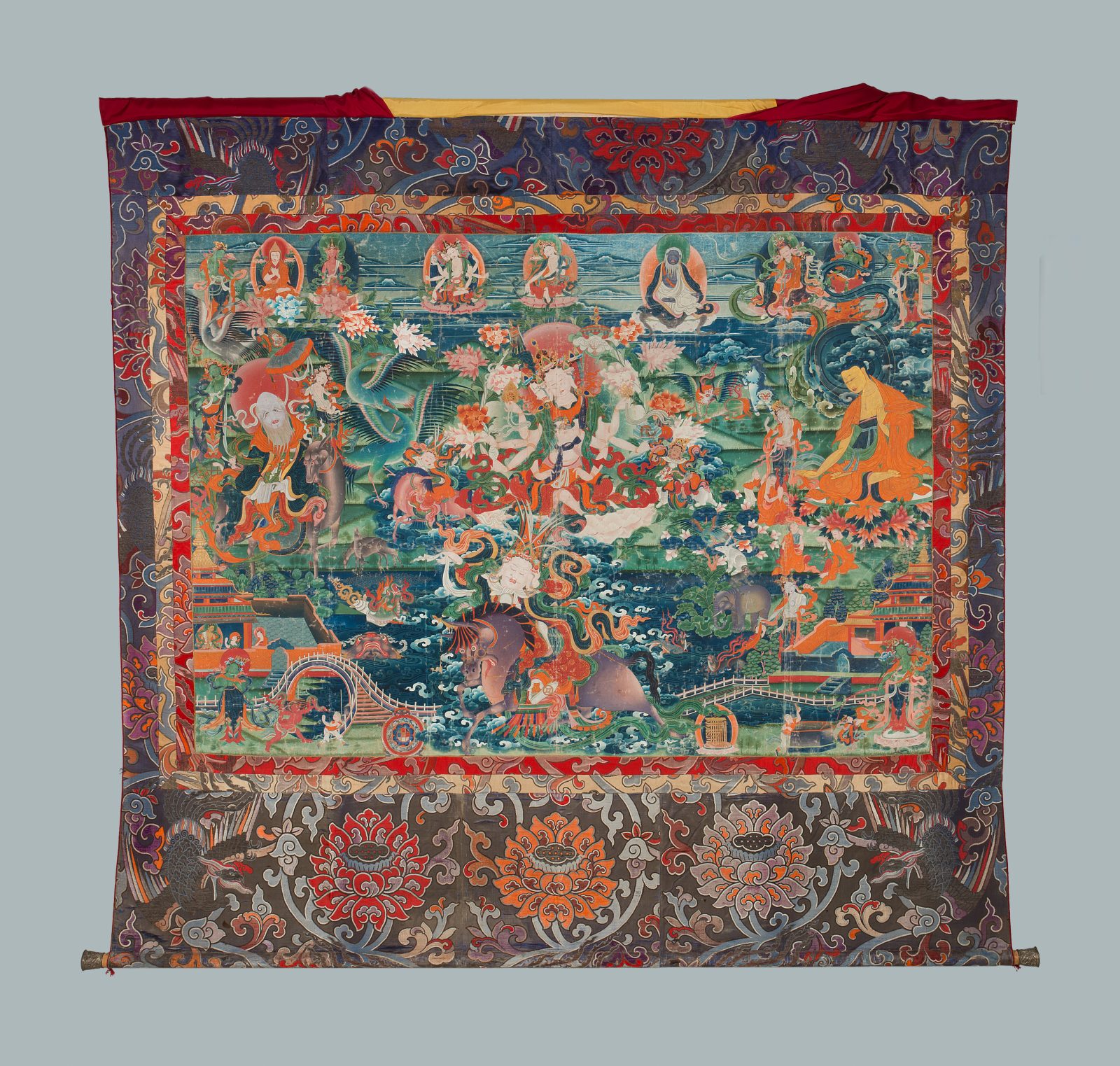
Tara Protecting from the Eight Fears; Kham Province, Southeastern Tibet; late 19th - early 20th century; Pigments on cloth with silk brocade; Rubin Museum of Himalayan Art, Gift of Dr. Michael Henss, Zurich; C2014.8

Tara Protecting from the Eight Fears; Kham Province, Southeastern Tibet; late 19th - early 20th century; Pigments on cloth with silk brocade; Rubin Museum of Himalayan Art, Gift of Dr. Michael Henss, Zurich; C2014.8
Acquired in 2016, this painting has the power to bestow blessings on its viewers. It is replete with color, texture, deities and animals, lush landscape elements, and compelling stories, all associated with protection, longevity, and auspiciousness.

Tara Protecting from the Eight Fears (detail); Kham Province, southeastern Tibet; late 19th-early 20th century; pigments on cloth with silk frame; Rubin Museum of Art, gift of Dr. Michael Henss, Zurich, Switzerland
The composition is centered on Tara, the popular Buddhist goddess of compassion and protection. She is depicted in a rarely-seen form—as the “Beneficial and Auspicious Tara”—white with four semi-wrathful faces (two white, one red, and one blue) and eight arms that hold the Eight Auspicious Symbols of Buddhism. In her left hands she holds the endless knot, pair of golden fish, treasure vase, and parasol. In her right hands she holds the wheel, lotus, conch, and victory banner. She is seated on a lotus and flanked by two small worldly protectors in warrior form.
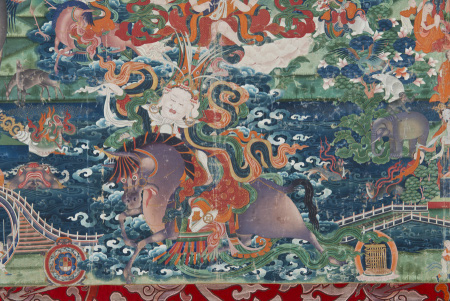
Gesar at the bottom center.
Beneath the central Tara is an image of a warrior hero, probably the great Tibetan folk hero Gesar riding a horse and wearing an elaborate hat with streamers. He holds a riding crop in his right hand and holds his left hand to his ear. On the left side of the painting is the “White Old Man,” a guardian of life and longevity. He is an important character in Tibetan masked cham dances during the New Year. He is flanked by the goddesses Green Tara and Sitatapatra, who holds a parasol and protects against supernatural danger. A large seated Buddha on the right side also offers protection. He has his right hand in the gesture of fearlessness, and he is being venerated by prostrating monks and disciples.
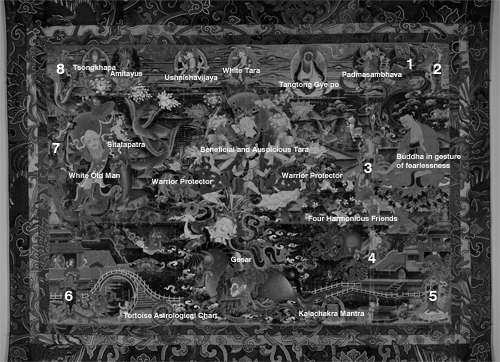
Identification of main scenes and figures.
The protective functions of this painting are enhanced by the narrative illustration of Tara offering protection from the Eight Fears in a series of vignettes around the periphery of the painting. These eight perils that might befall travelers are (clockwise from upper right, see diagram): 1) elephants, 2) fire, 3) lions, 4) drowning, 5) captivity, 6) evil spirits/illness, 7) thieves, and 8) snakes.

Longevity figures in the upper register.
Several figures in the upper register of the painting ensure longevity. There are the three deities of long life: Amitayus, Ushnishavijaya, and White Tara. Next to Tara, toward the right side of the painting, is an elderly figure with dark skin and long white hair and beard seated in meditation atop an animal skin. This is Tangtong Gyelpo, who is known for creating new medicinal formulas for healing and longevity. As such he is often depicted with the three deities of long life.
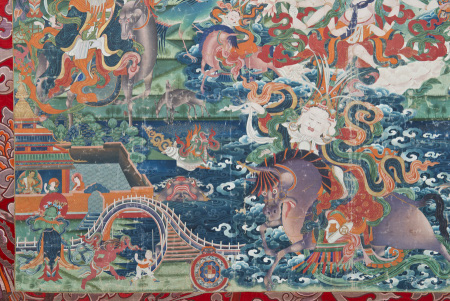
Lower-left corner.
This type of scroll painting, with its rich Chinese silk brocade frame, has a horizontal format that is emphasized by the vibrant landscape background. Note the horizontality of the water, hills, clouds, architecture, and even the feathers of the birds’ wings. The textured painting technique, seen in the landscape and haloes, is unique. The painting displays many elements characteristic of a southeastern Tibetan style called Khamri, particularly the lush Chinese-style landscaping, the birds, and the round bridge in the lower-left corner.
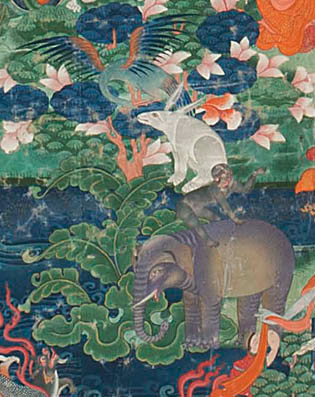
The Four Harmonious Friends.
The painting is brimming with landscape features and small animals. Note the illustration of the Four Harmonious Friends (a bird, rabbit, monkey, and elephant sitting on each other’s backs) to the left of Gesar as well as the auspicious talismans flanking him: a tortoise from the astrological chart and the Kalachakra mantra.
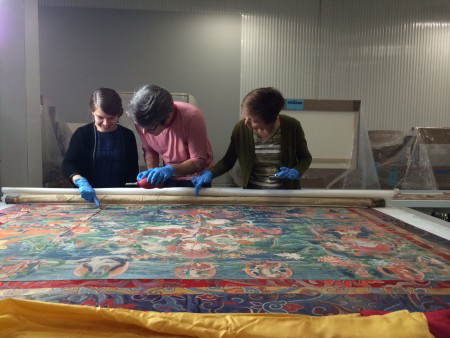
Members of the Rubin’s curatorial and collections management departments take a closer look at the painting’s many details.
The efficacy of these auspicious figures and elements is shown in the story of the painting’s long journey from Tibet to its new home at the Rubin. The painting was originally owned by the family of Dagyab Rinpoche in the Dagyab area of western Kham region in eastern Tibet. The family carried the painting with them when they escaped from Tibet to Nepal in 1959 and later brought it with them to Europe. The painting helped to ensure the safety of the family during their arduous journey. It was generously offered as a gift to the Rubin Museum by Dr. Michael Henss in 2014. Learn more about this object.

Natasha Kimmet is a former curatorial fellow at the Rubin Museum of Art. Natasha developed an interest in Asian art and architecture while pursuing her BA at Bates College, partly inspired by a study abroad experience in the Himalayas. After college, she worked at art galleries in New York and as a volunteer at the Rubin before moving to London to complete an MA in the History of Art at the School of Oriental and African Studies, University of London.
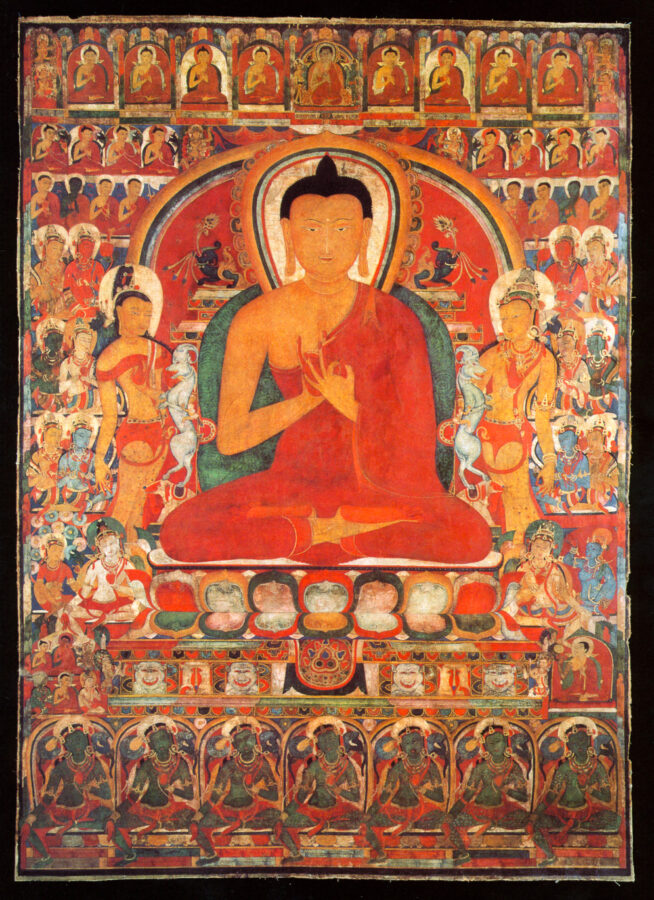
Rubin Museum
150 W. 17th St., NYC
Get the latest news and stories from the Rubin, plus occasional information on how to support our work.